Micro Star MS3822 WLAN 802.11b/g/n 1T1R Slim Module User Manual UserMan I4L MS3822 rev
Micro Star International Co Ltd WLAN 802.11b/g/n 1T1R Slim Module UserMan I4L MS3822 rev
Contents
- 1. UserMan_I4L-MS3822_rev.
- 2. User Manual Host
- 3. User Manual Host Addendum
- 4. User Manual Module
UserMan_I4L-MS3822_rev.
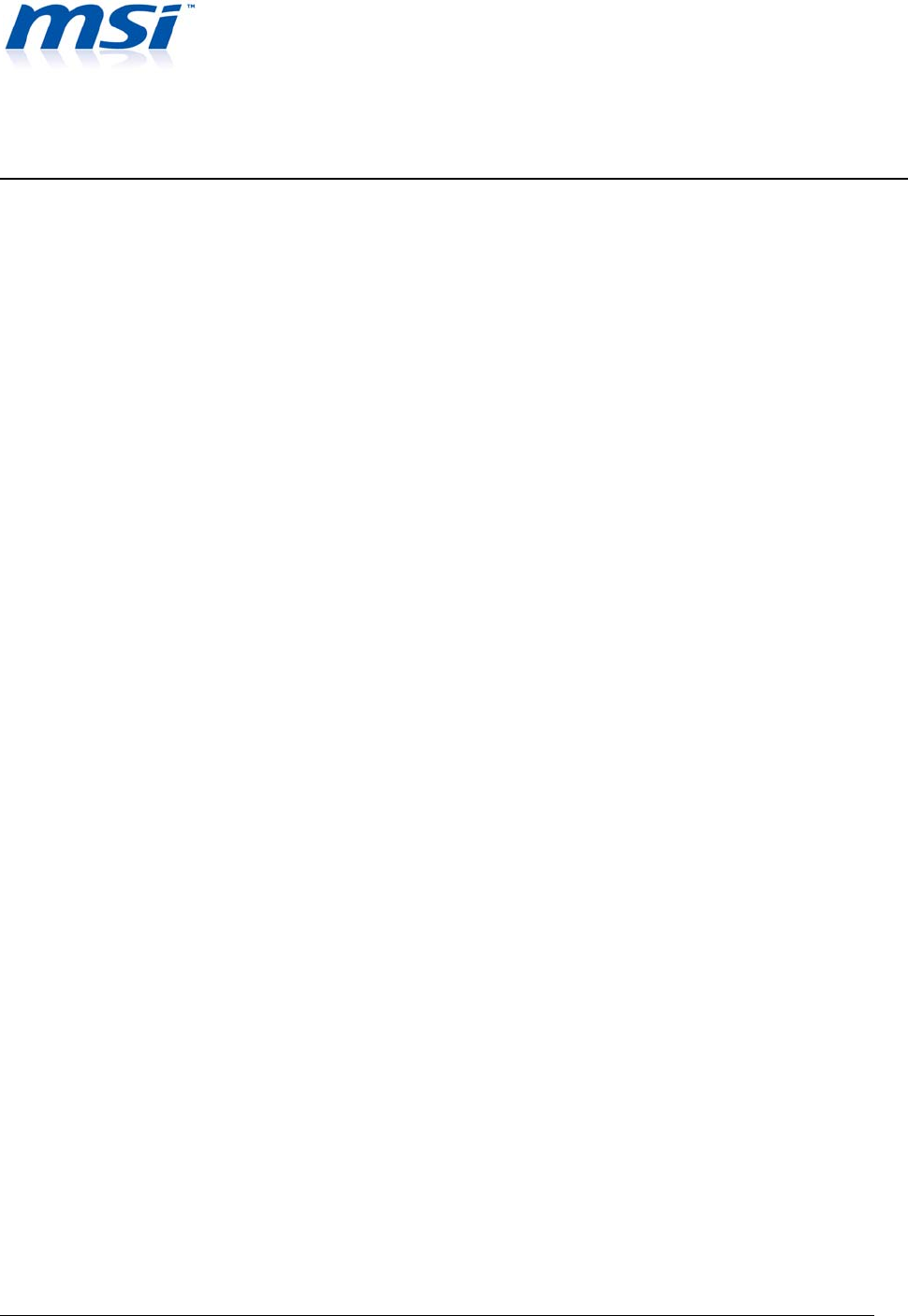
WLAN 802.11bgn 1T1R slim module
Application Note
Slim Module
Rev 1.3
Micro-Star International Co., Copyright 2010
Proprietary and Confidential
1
APPLICATION NOTE
MS-3822
WLAN 802.11bgn 1T1R Slim Module
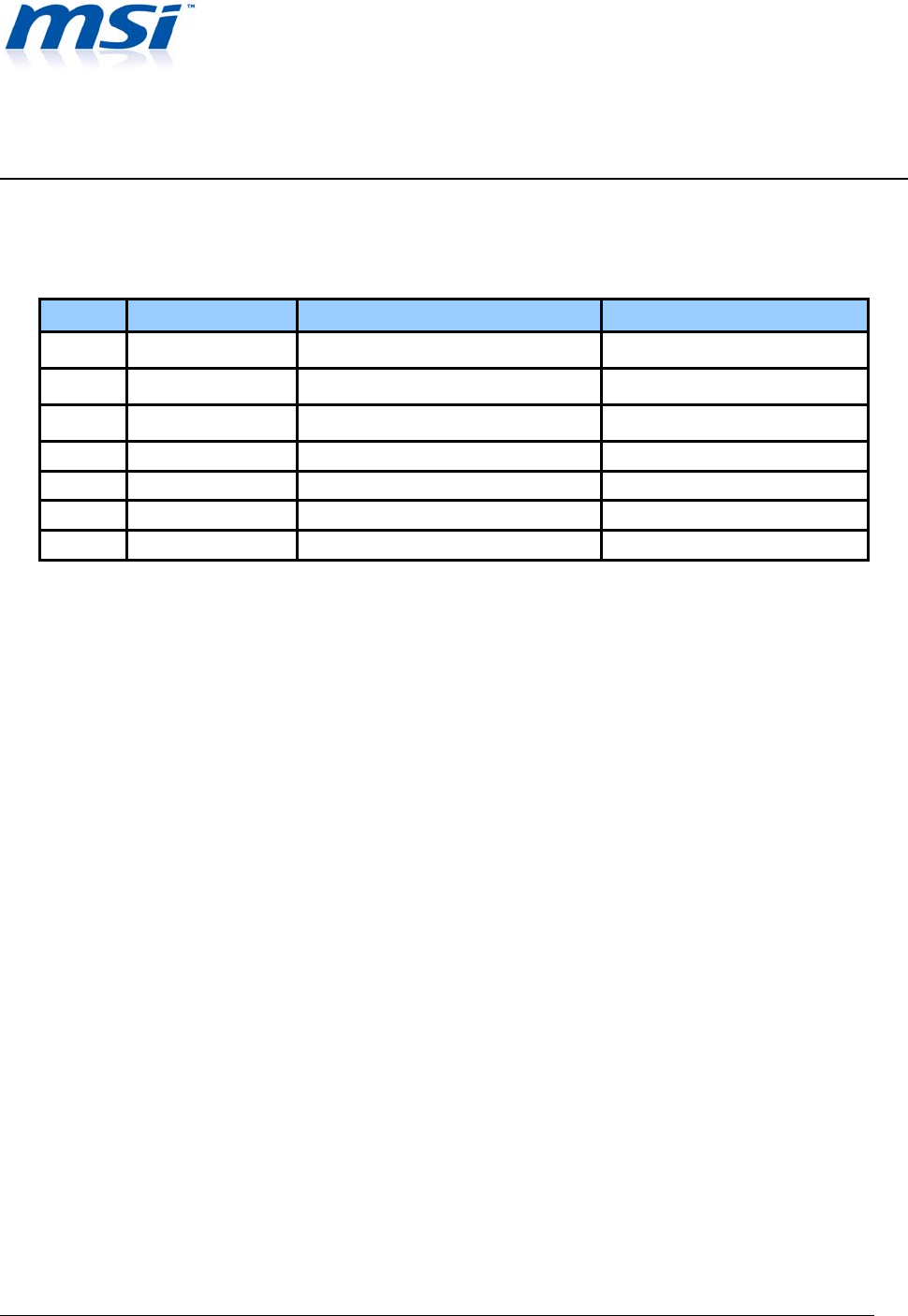
WLAN 802.11bgn 1T1R slim module
Application Note
Slim Module
Rev 1.3
Micro-Star International Co., Copyright 2010
Proprietary and Confidential
2
Revision History
Revision Date Description Author/Revised by
1.0 2010/02/22 First version Benson
2.0 2010/4/14 Update PIN definition Jackie
3.0 2010/5/12 Add foil dimension definition Jackie
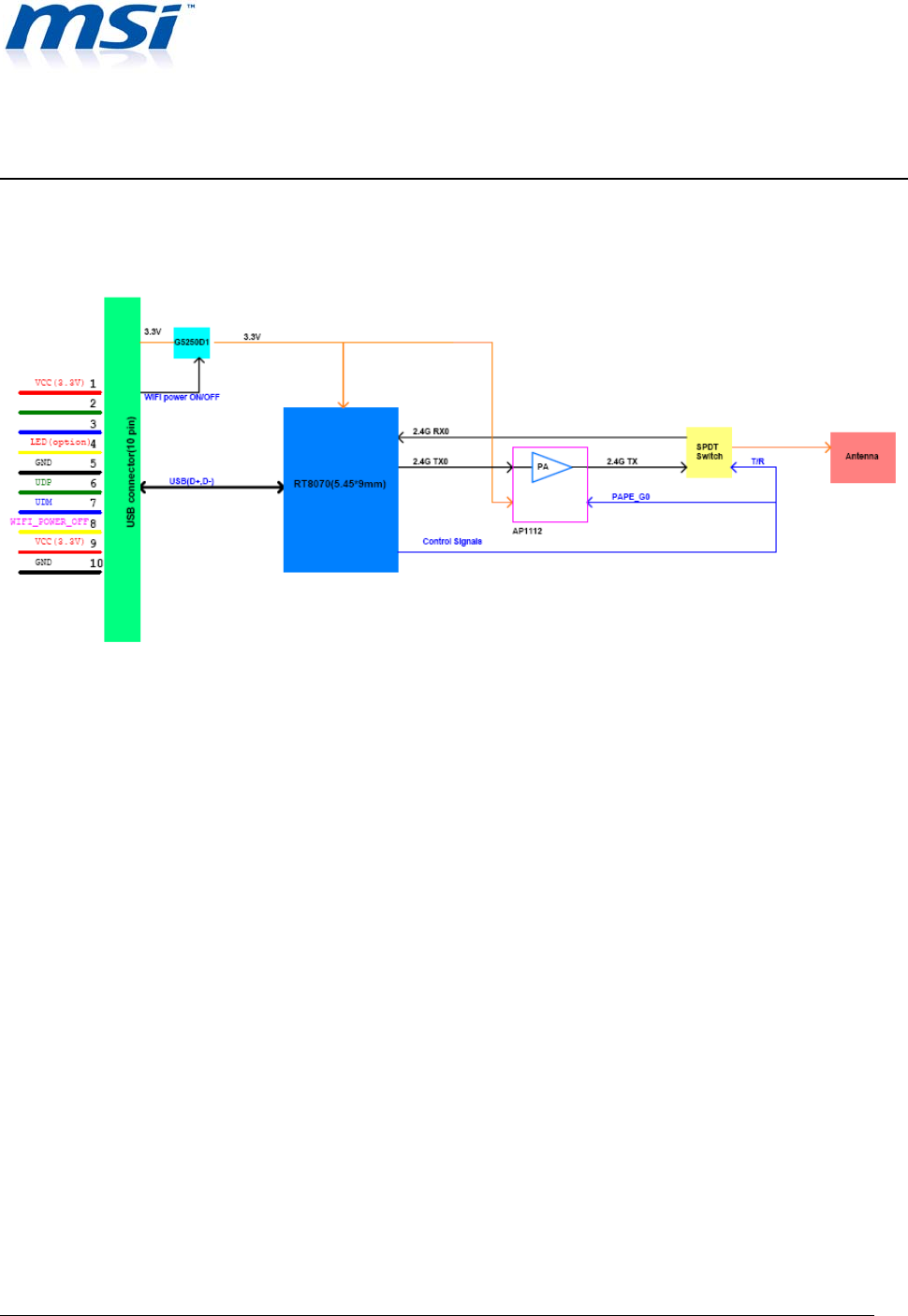
WLAN 802.11bgn 1T1R slim module
Application Note
Slim Module
Rev 1.3
Micro-Star International Co., Copyright 2010
Proprietary and Confidential
3
1. Slim Module Block Diagram
Figure1: Slim Module Block Diagram
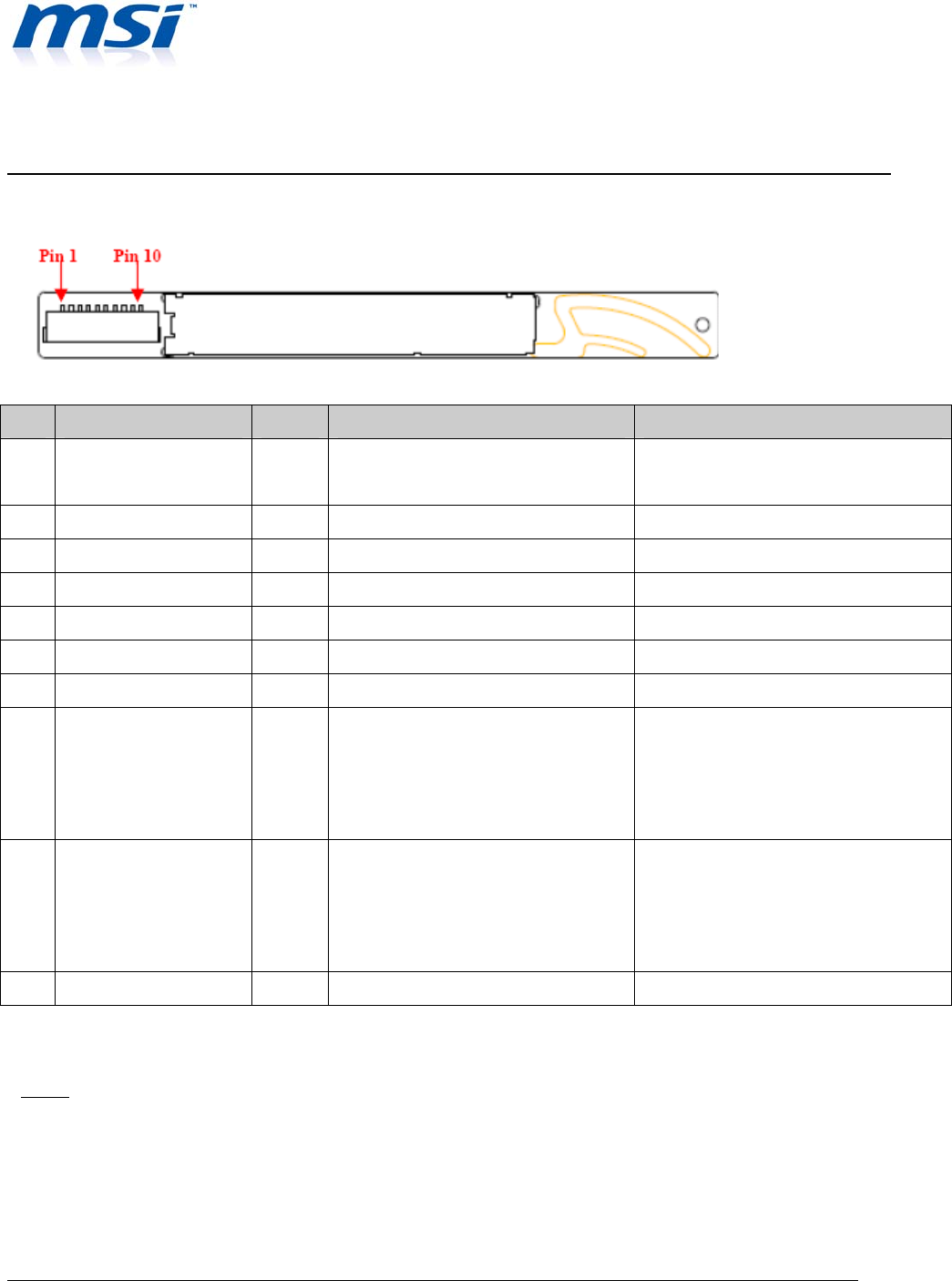
WLAN 802.11bgn 1T1R slim module
Application Note
Slim Module
Rev 1.3
Micro-Star International Co., Copyright 2010
Proprietary and Confidential
4
2. Slim Module Pin Description
Table1: Slim Module Pin Description
Pin Name Type Description Note
1 3.3V P 3.3V from DC Power Supply
Input for Module Circuits
z Bypassing Capacitor Free
z Ferrite Bead Free
2 NC NC
3 NC NC
4 NC NC
5 GND P Ground
6 D+ I/O D+ Line of USB2.0 WIFI D+
7 D- I/O D- Line of USB2.0 WIFI D-
8 WI-FI_RADIO_OFF
I/O WI-FI_RADIO_OFF Support System Module Turn
radio ON/OFF WIFI Function
(Never floating)
WiFi on: High, off: Low
9 3.3V/Wi-Fi LED P/I/O 3.3V from DC Power Supply
/Wi-Fi LED
z Bypassing Capacitor Free
z Ferrite Bead Free
LED on: High,
LED off: Low
10 GND P Ground
*Note:
(1) I: Input
(2) O: Output
(3) I/O: Bi-Direction
(4) P: Power
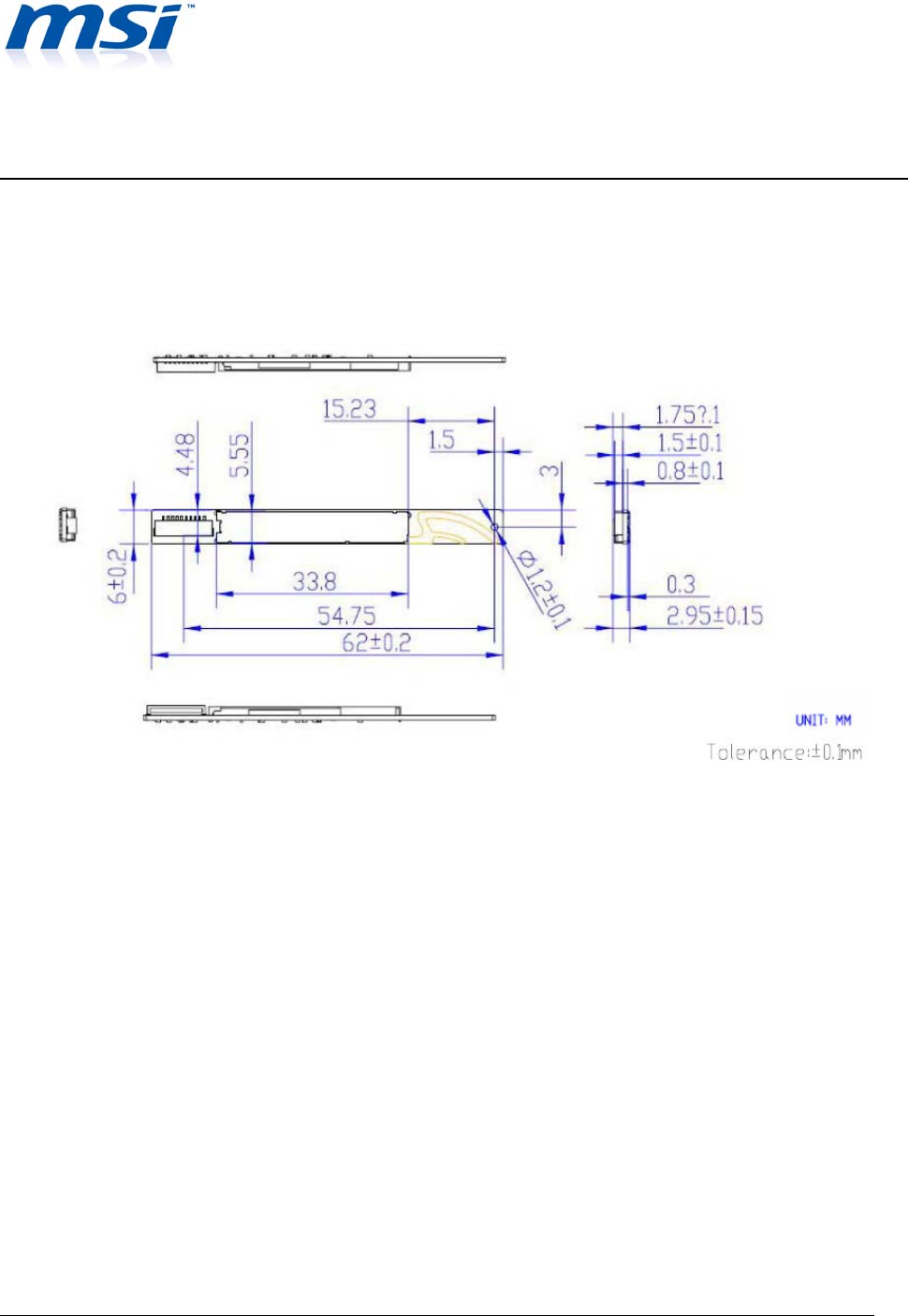
WLAN 802.11bgn 1T1R slim module
Application Note
Slim Module
Rev 1.3
Micro-Star International Co., Copyright 2010
Proprietary and Confidential
5
3. Mechanical Specifications
3.1 PCB Mechanical Drawing
Figure2: Slim Module Dimension
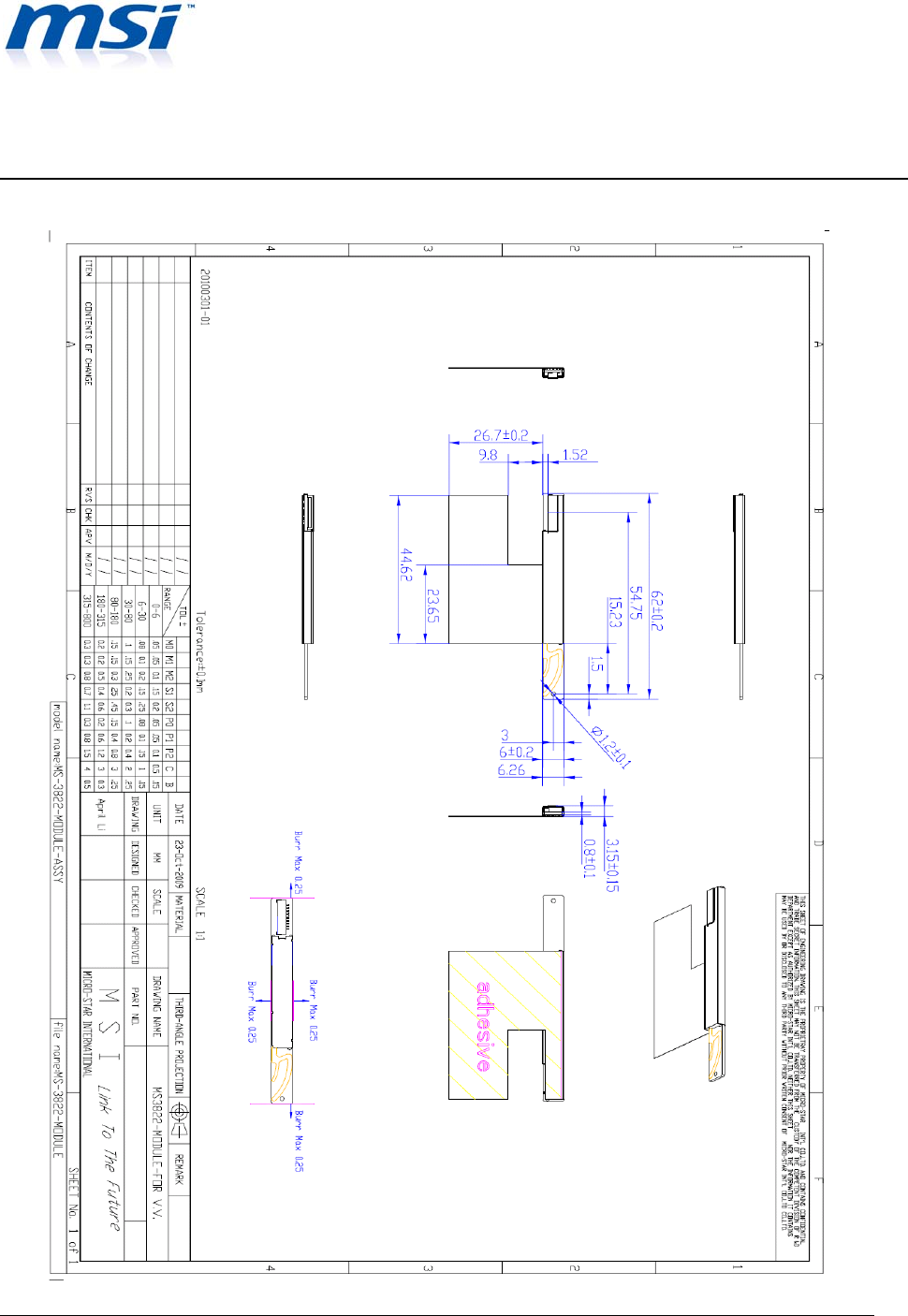
WLAN 802.11bgn 1T1R slim module
Application Note
Slim Module
Rev 1.3
Micro-Star International Co., Copyright 2010
Proprietary and Confidential
6
3.2 Aluminum Label with PCBA Mechanical Drawing
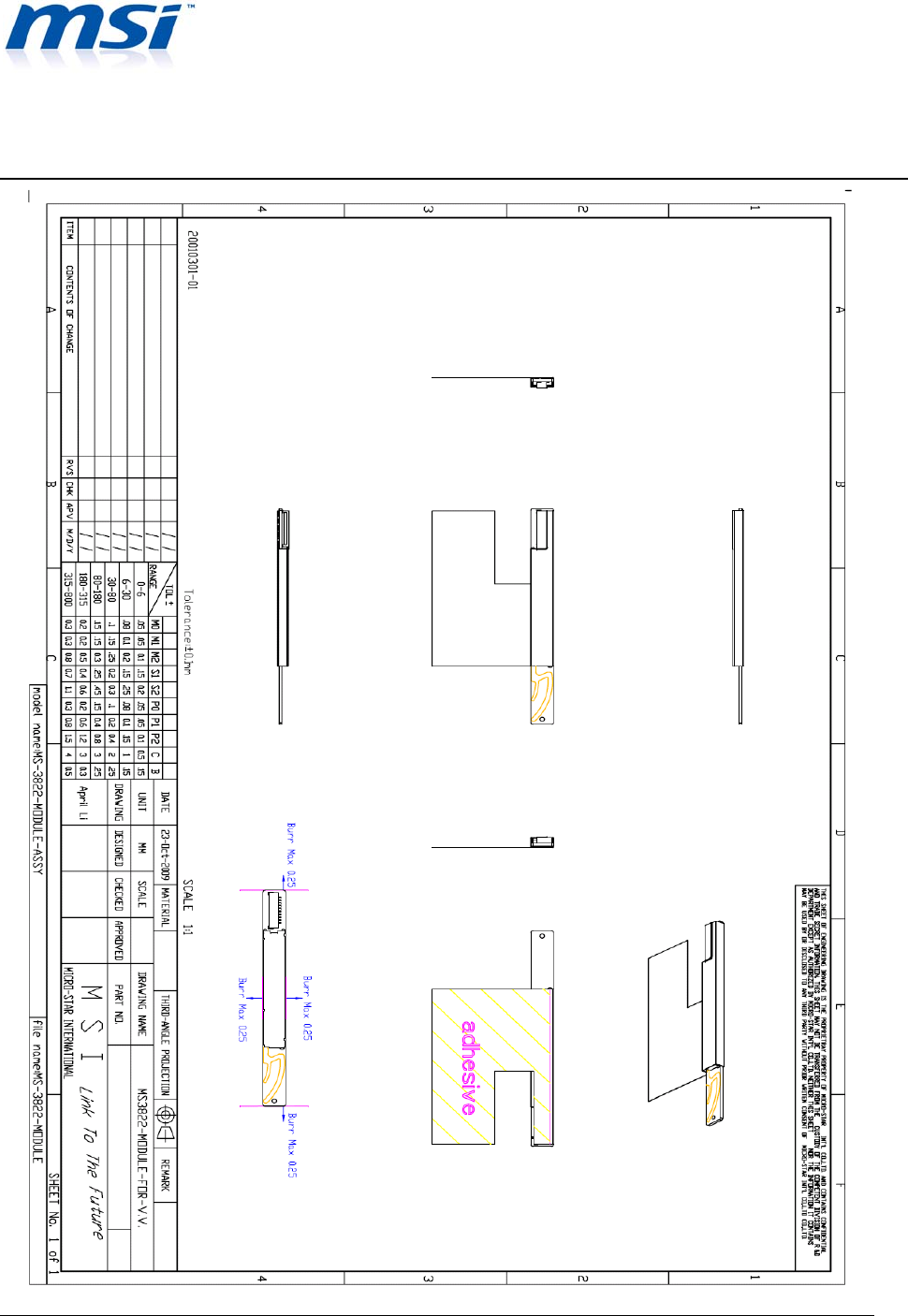
WLAN 802.11bgn 1T1R slim module
Application Note
Slim Module
Rev 1.3
Micro-Star International Co., Copyright 2010
Proprietary and Confidential
7
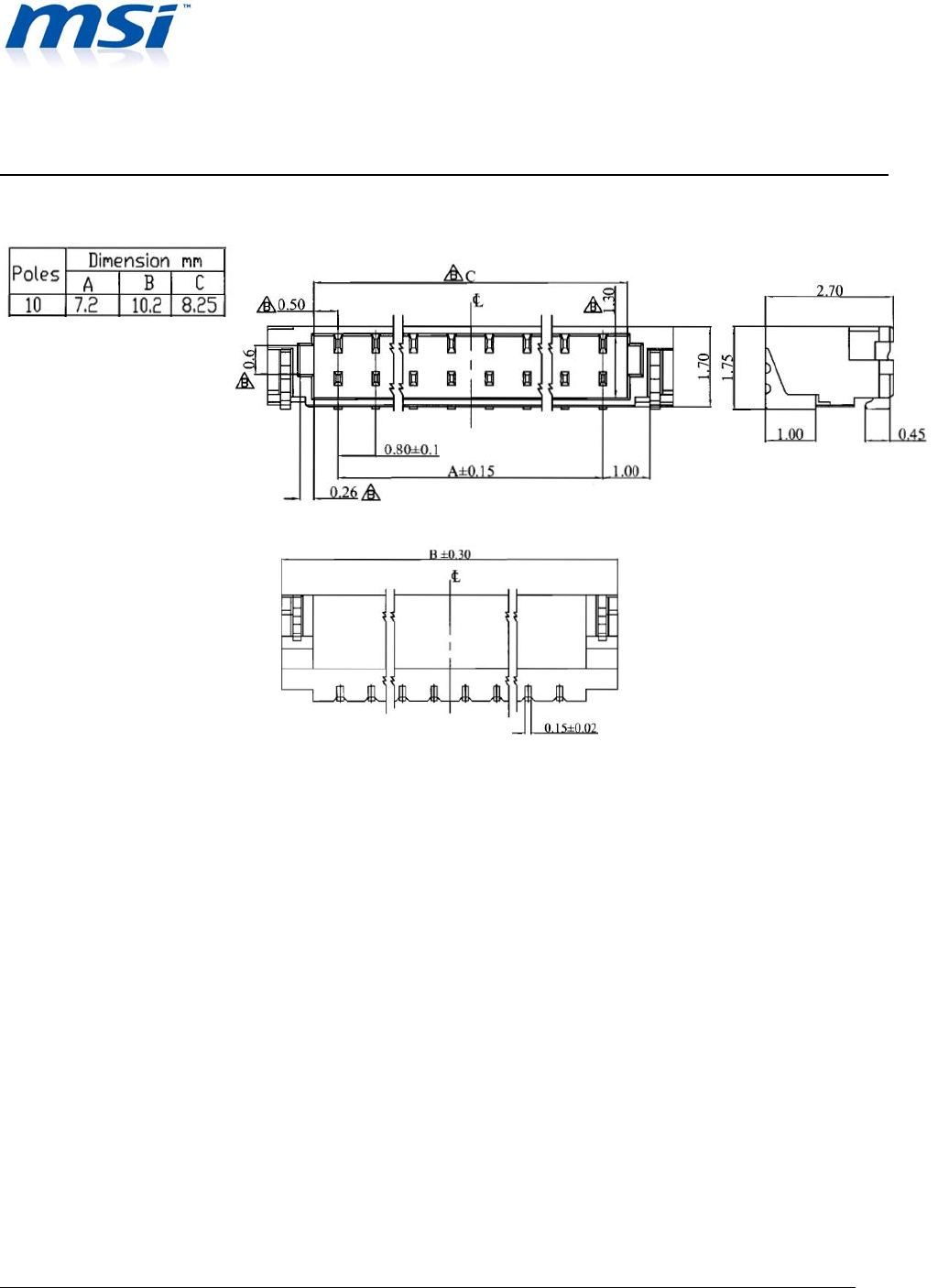
WLAN 802.11bgn 1T1R slim module
Application Note
Slim Module
Rev 1.3
Micro-Star International Co., Copyright 2010
Proprietary and Confidential
8
3.3 Connector Mechanical Drawing
Figure3: Slim Module connector Dimension
3.3 Recommended Cable Length and Gauge
UL1571 32AWG HOOK UP WIRE OD=0.38mm, LENGTH=650mm (MAX.)
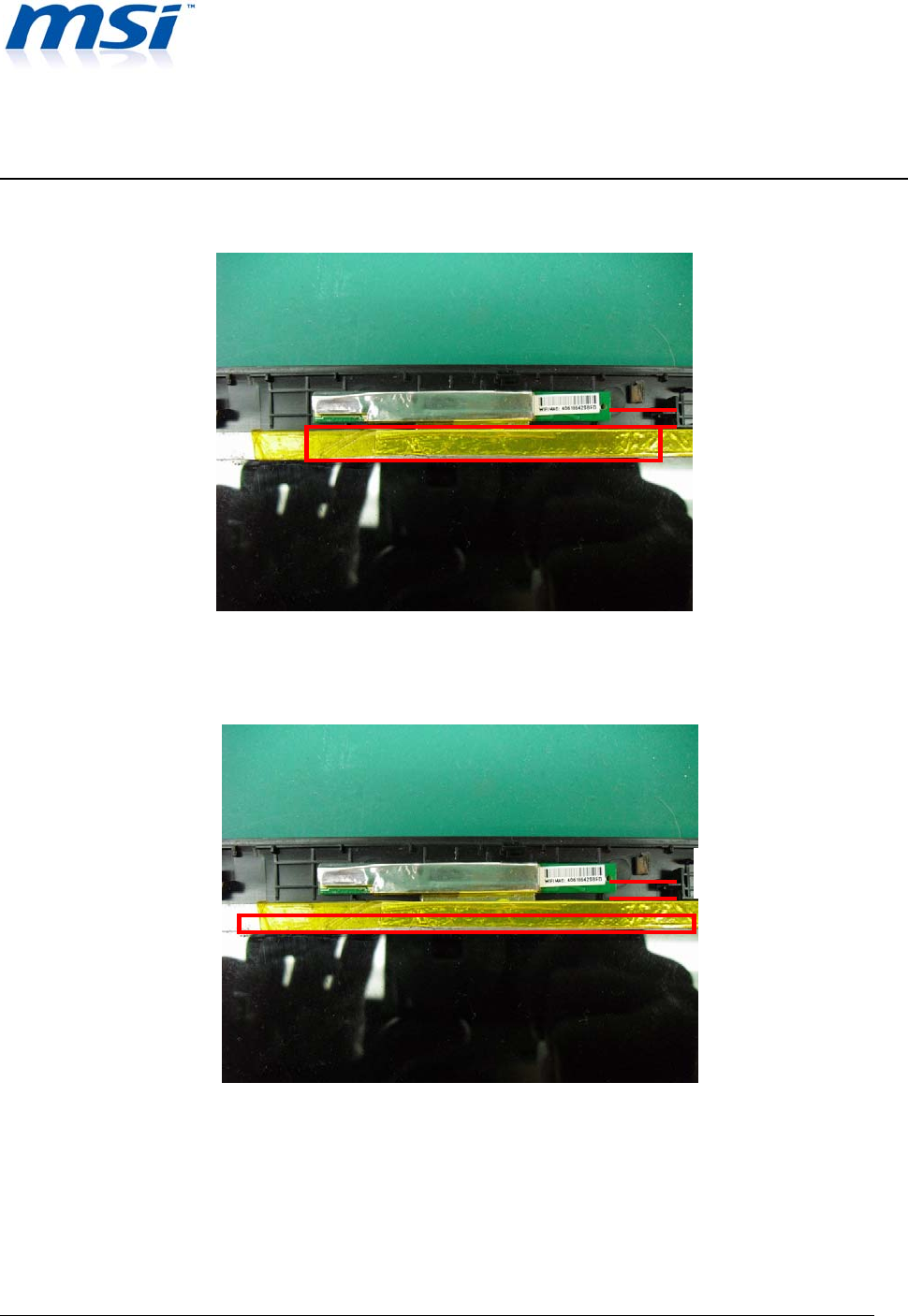
WLAN 802.11bgn 1T1R slim module
Application Note
Slim Module
Rev 1.3
Micro-Star International Co., Copyright 2010
Proprietary and Confidential
9
4. Recommended Assembly for Slim Module
Applying insulating tape or other insulator and adhere it onto the module or LCD panel. This is to
prevent the module touching on the panel ground. (please note: This gap and insulating tap are
necessary when the noise inducing from the LCD panel)
To achieve 40% antenna efficiency, Giving at least 5mm gap and applying insulating tap in between
module & panel for better isolation.
5mm gap
5mm gap
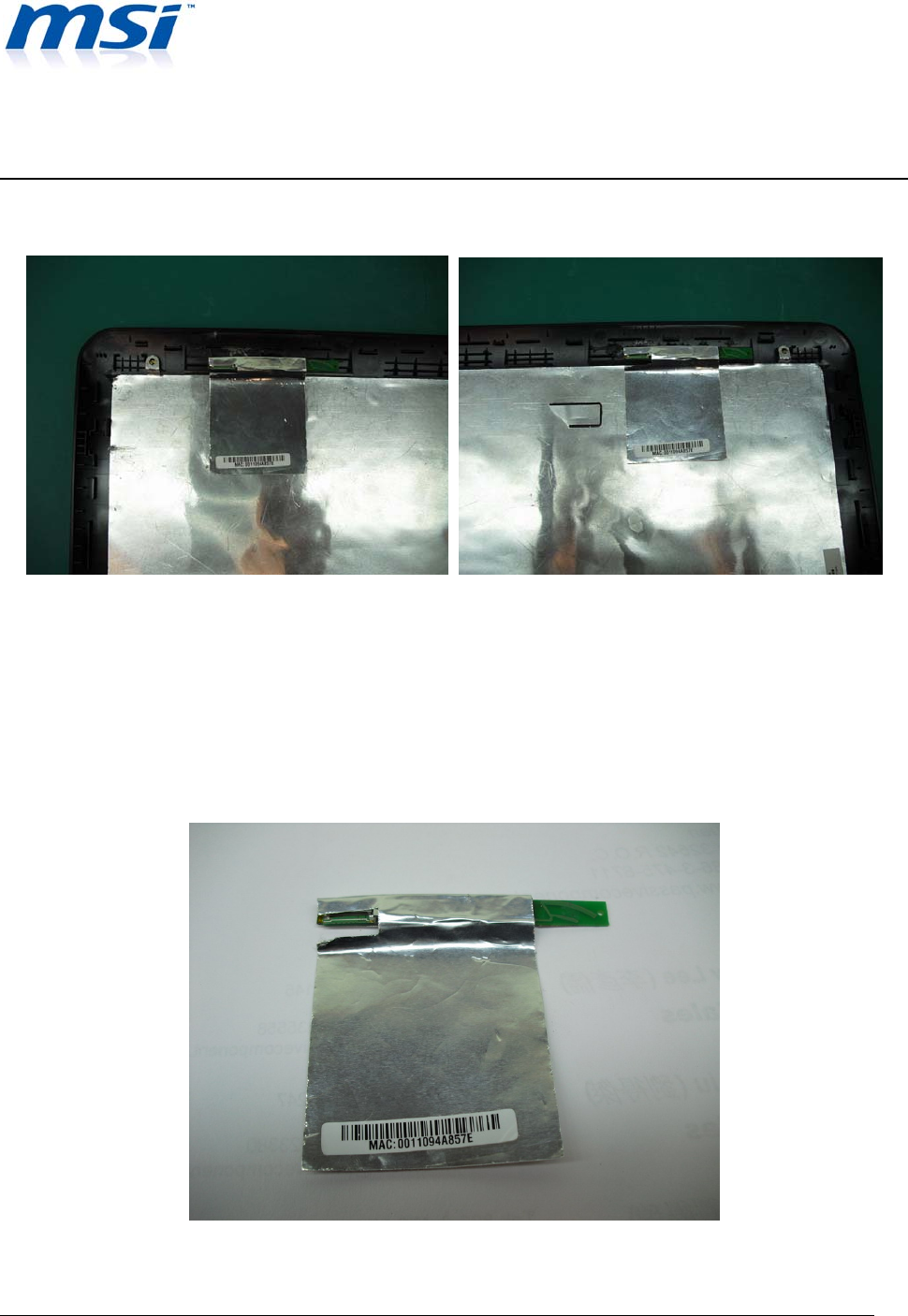
WLAN 802.11bgn 1T1R slim module
Application Note
Slim Module
Rev 1.3
Micro-Star International Co., Copyright 2010
Proprietary and Confidential
10
5. Solution for Thermal Reduction and Improving Antenna Gain
Adopting copper /aluminum foil or heat sink and then adhere it onto the top of slim module
shielding case. The bigger the foil/heat sink, the better the thermal conduction. Please note that
the size of foil/heat sink should just fit properly onto the shielding case. Foil/ heat sink size larger
than shielding area will impact the antenna performance. See below picture as a reference for
correct cutting size. Copper foil is highly recommended as it will enhance antenna performance.
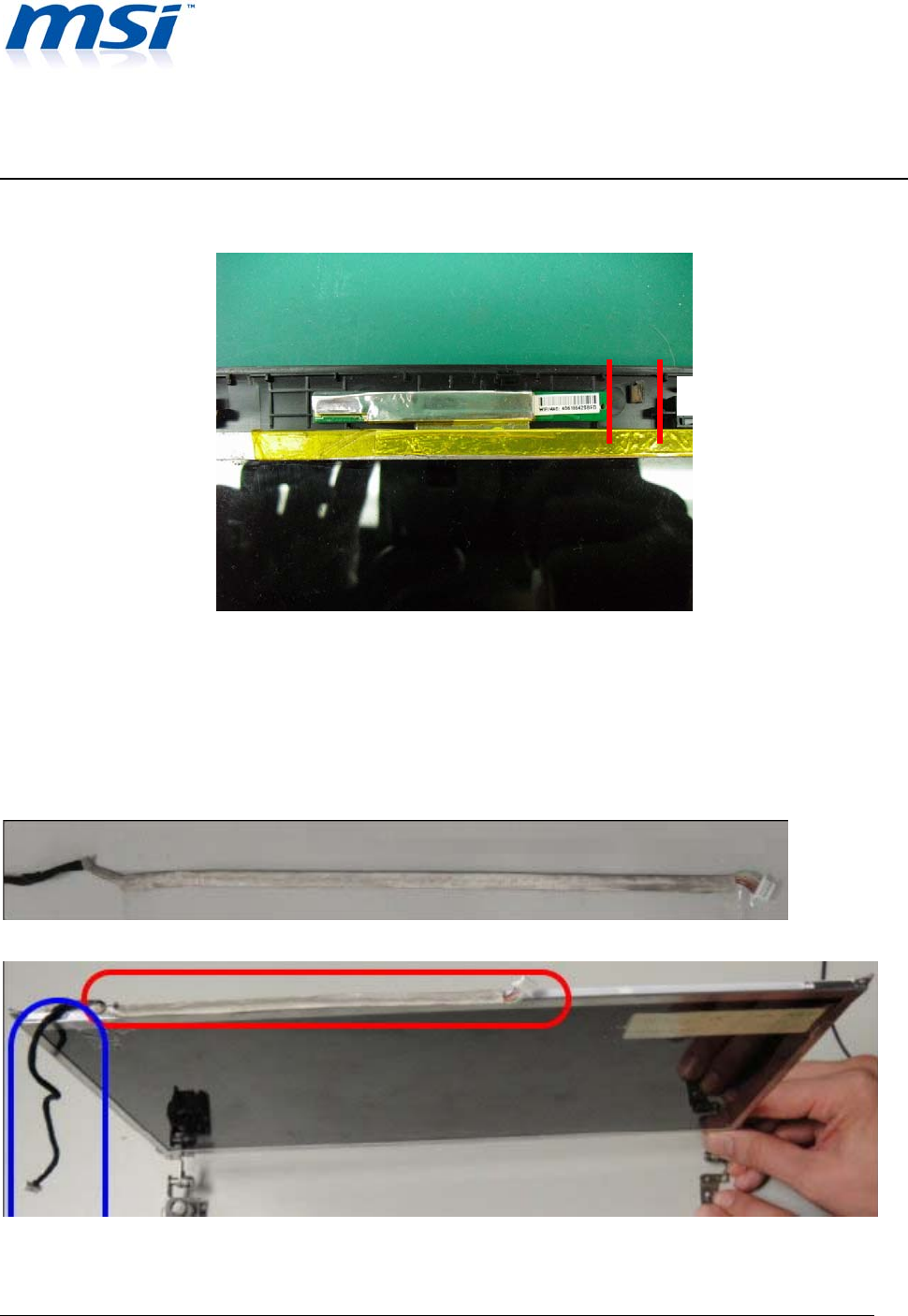
WLAN 802.11bgn 1T1R slim module
Application Note
Slim Module
Rev 1.3
Micro-Star International Co., Copyright 2010
Proprietary and Confidential
11
6. Recommended Placement for Slim Module’s Antennas.
Leaving a gap between the slim module and NB housing ( the screw hole) for better antenna
performance.
For Wi-Fi side, 20mm gap is recommended.
Note: please avoid any metal parts to cover, touch or surround with antenna.
Remark: If the webcam cable must go through MS-3822 module, please routing the top of
panel edge and “flat cable” is the only solution to adopt.
Webcam cable (flat cable)
(Through the top of panel edge)
20mm GAP
(
Wi-Fi
)
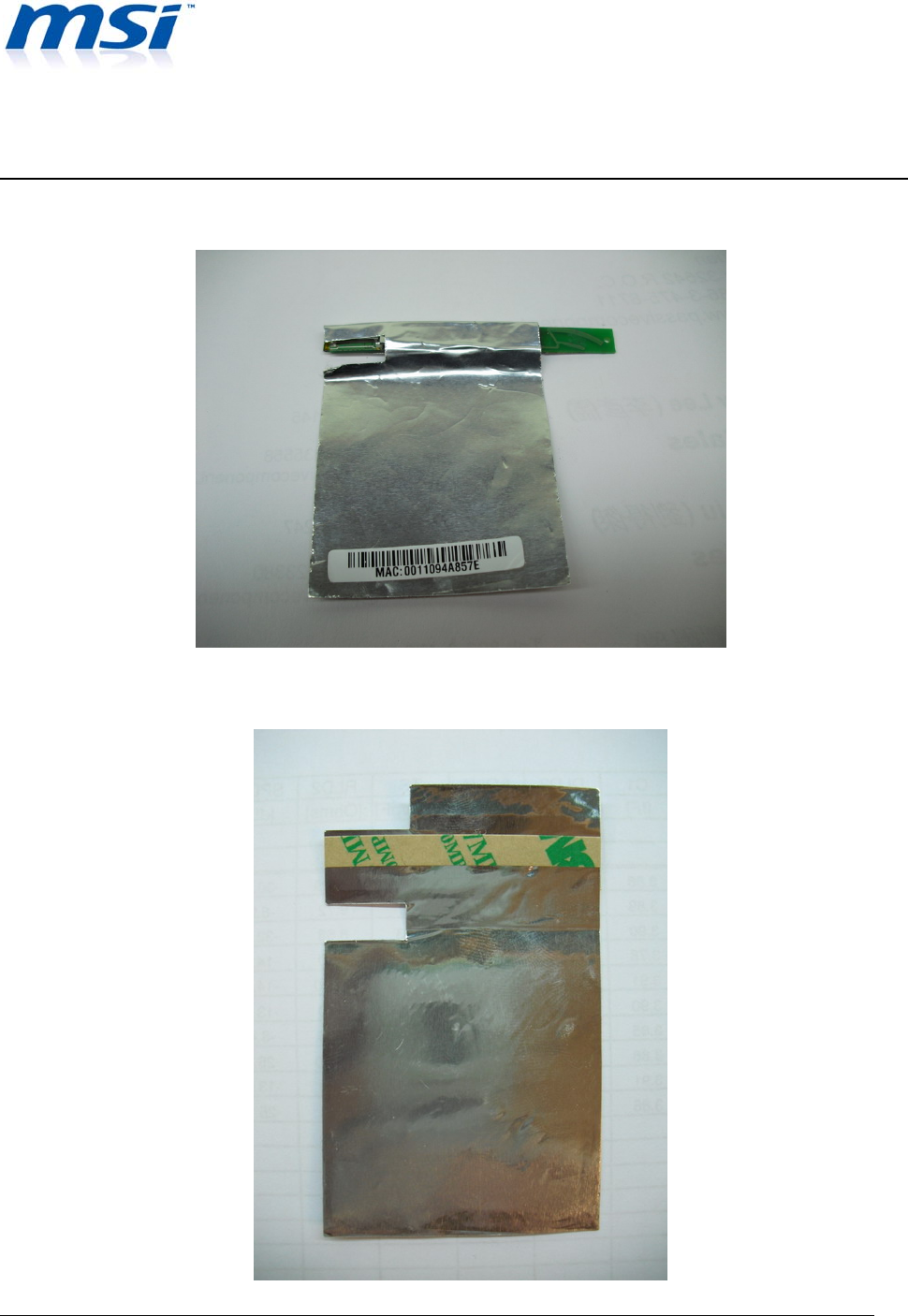
WLAN 802.11bgn 1T1R slim module
Application Note
Slim Module
Rev 1.3
Micro-Star International Co., Copyright 2010
Proprietary and Confidential
12
7. Recommended The Size of Copper /Aluminum Foil
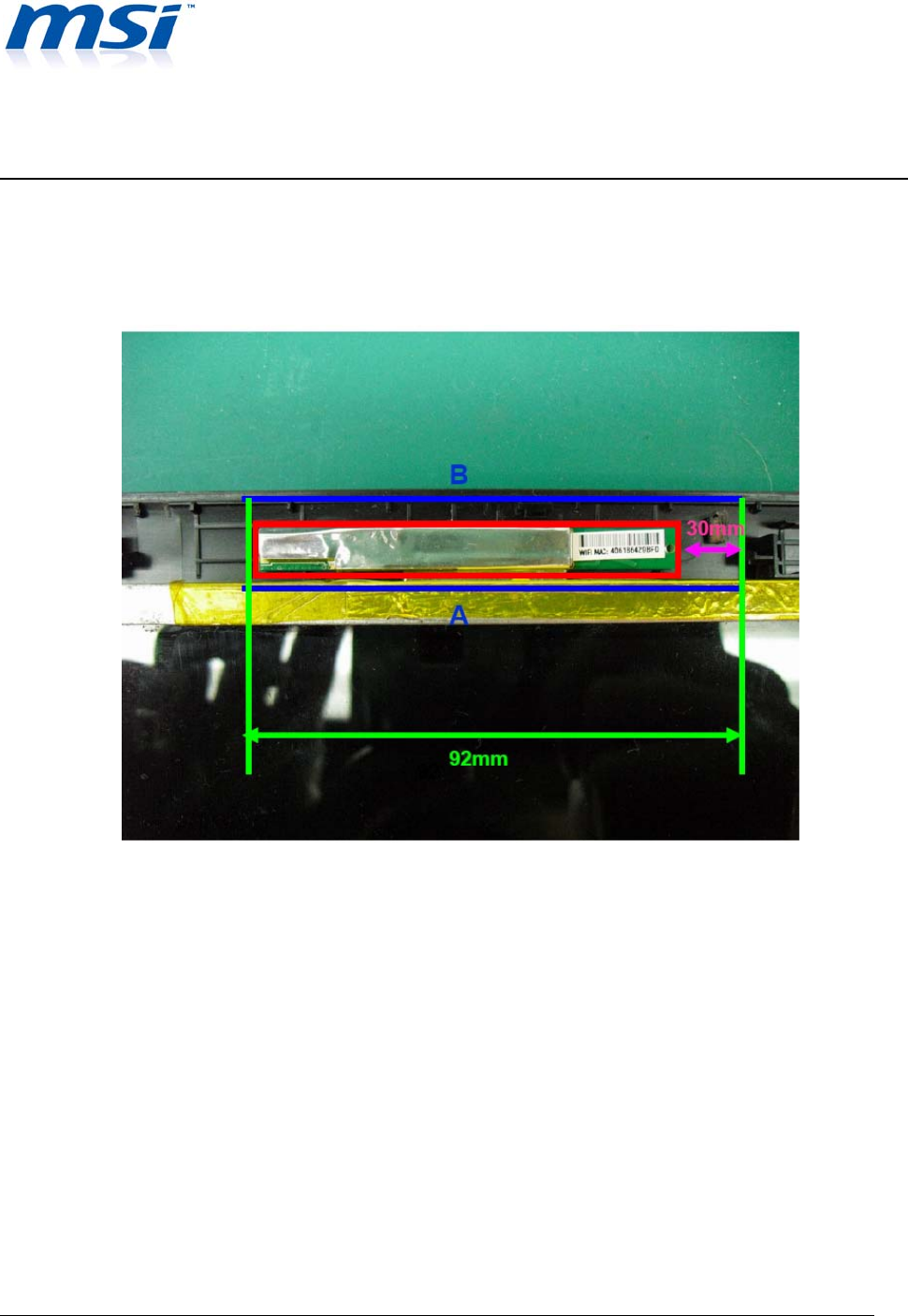
WLAN 802.11bgn 1T1R slim module
Application Note
Slim Module
Rev 1.3
Micro-Star International Co., Copyright 2010
Proprietary and Confidential
13
8. Recommended The EMI Coating Area
We suggest the area of EMI Coating must be within the length of Green line: 92mm and the width
between blue line A and B (from the end of panel to end of A side). Don't Coating exceed this area.

v1.0
U.S. Regulatory Wireless Notice
Federal Communication Commission Interference Statement
This equipment has been tested and found to comply with the limits for a Class B
digital device, pursuant to Part 15 of the FCC Rules. These limits are designed to
provide reasonable protection against harmful interference in a residential installation.
This equipment generates, uses and can radiate radio frequency energy and, if not
installed and used in accordance with the instructions, may cause harmful
interference to radio communications. However, there is no guarantee that
interference will not occur in a particular installation. If this equipment does cause
harmful interference to radio or television reception, which can be determined by
turning the equipment off and on, the user is encouraged to try to correct the
interference by one of the following measures:
- Reorient or relocate the receiving antenna.
- Increase the separation between the equipment and receiver.
- Connect the equipment into an outlet on a circuit different from that
to which the receiver is connected.
- Consult the dealer or an experienced radio/TV technician for help.
FCC Caution: Any changes or modifications not expressly approved by the party
responsible for compliance could void the user's authority to operate this equipment.
This device complies with Part 15 of the FCC Rules. Operation is subject to the
following two conditions: (1) This device may not cause harmful interference, and (2)
this device must accept any interference received, including interference that may
cause undesired operation.
IMPORTANT NOTE:
FCC Radiation Exposure Statement:
This equipment complies with FCC radiation exposure limits set forth for an
uncontrolled environment. This equipment should be installed and operated with
minimum distance 20cm between the radiator & your body.
This transmitter must not be co-located or operating in conjunction with any other
antenna or transmitter.

v1.0
This device is intended only for OEM integrators under the following
conditions:
1) The antenna must be installed such that 20 cm is maintained between the
antenna and users, and
2) The transmitter module may not be co-located with any other transmitter or
antenna,
3) For all products market in US, OEM has to limit the operation channels in CH1
to CH11 for 2.4G band by supplied firmware programming tool. OEM shall not
supply any tool or info to the end-user regarding to Regulatory Domain change.
As long as 3 conditions above are met, further transmitter test will not be required.
However, the OEM integrator is still responsible for testing their end-product for any
additional compliance requirements required with this module installed
IMPORTANT NOTE: In the event that these conditions can not be met (for example
certain laptop configurations or co-location with another transmitter), then the FCC
authorization is no longer considered valid and the FCC ID can not be used on the
final product. In these circumstances, the OEM integrator will be responsible for
re-evaluating the end product (including the transmitter) and obtaining a separate
FCC authorization.
IMPORTANT NOTE: In the event that these conditions can not be met (for example
certain laptop configurations or co-location with another transmitter), then the FCC
authorization is no longer considered valid and the FCC ID can not be used on the
final product. In these circumstances, the OEM integrator will be responsible for
re-evaluating the end product (including the transmitter) and obtaining a separate
FCC authorization.
End Product Labeling
This transmitter module is authorized only for use in device where the antenna may
be installed such that 20 cm may be maintained between the antenna and users. The
final end product must be labeled in a visible area with the following: “Contains FCC
ID: I4L-MS3822”.
Manual Information To the End User
The OEM integrator has to be aware not to provide information to the end user
regarding how to install or remove this RF module in the user’s manual of the end
product which integrates this module.
The end user manual shall include all required regulatory information/warning as show
in this manual.
Canadian Regulatory Wireless Notice
This device complies with RSS-210 of the Industry Canada Rules. Operation is subject
to the following two conditions:
1) this device may not cause interference and
2) this device must accept any interference, including interference that may cause
undesired operation of the device

v1.0
IMPORTANT NOTE:
IC Radiation Exposure Statement:
This equipment complies with IC radiation exposure limits set forth for an uncontrolled
environment. This equipment should be installed and operated with minimum distance
20cm between the radiator and your body.
This device is intended only for OEM integrators under the following conditions:
1) The antenna must be installed such that 20 cm is maintained between the antenna
and users, and
2) The transmitter module may not be co-located with any other transmitter or antenna,
3) For all products market in Canada, OEM has to limit the operation channels in CH1 to
CH11 for 2.4G band by supplied firmware programming tool. OEM shall not supply
any tool or info to the end-user regarding to Regulatory Domain change. As long as 3
conditions
above are met, further transmitter test will not be required. However, the OEM integrator is
still responsible for testing their end-product for any additional compliance requirements
required with this module installed (for example, digital device emissions, PC peripheral
requirements, etc.).
MPORTANT NOTE: In the event that these conditions cannot be met (for example certain
laptop
configurations or co-location with another transmitter), then the IC authorization is no
longer considered valid and this ID cannot be used on the final product. In these
circumstances, the OEM integrator will be responsible for re-evaluating the end product
(including the transmitter) and obtaining a separate Canada IC authorization
End Product Labeling
This transmitter module is authorized only for use in device where the antenna may be
installed such that 20 cm may be maintained between the antenna and users. The final
end product must be labeled in a visible area with the following: “Contains IC:
3715A-MS3822.
Manual Information To the End User
The OEM integrator has to be aware not to provide information to the end user regarding
how to install or remove this RF module in the user’s manual of the end product which
integrates this module. The end user manual shall include all required regulatory
information/warning as show in this manual.